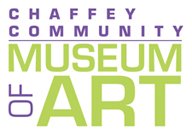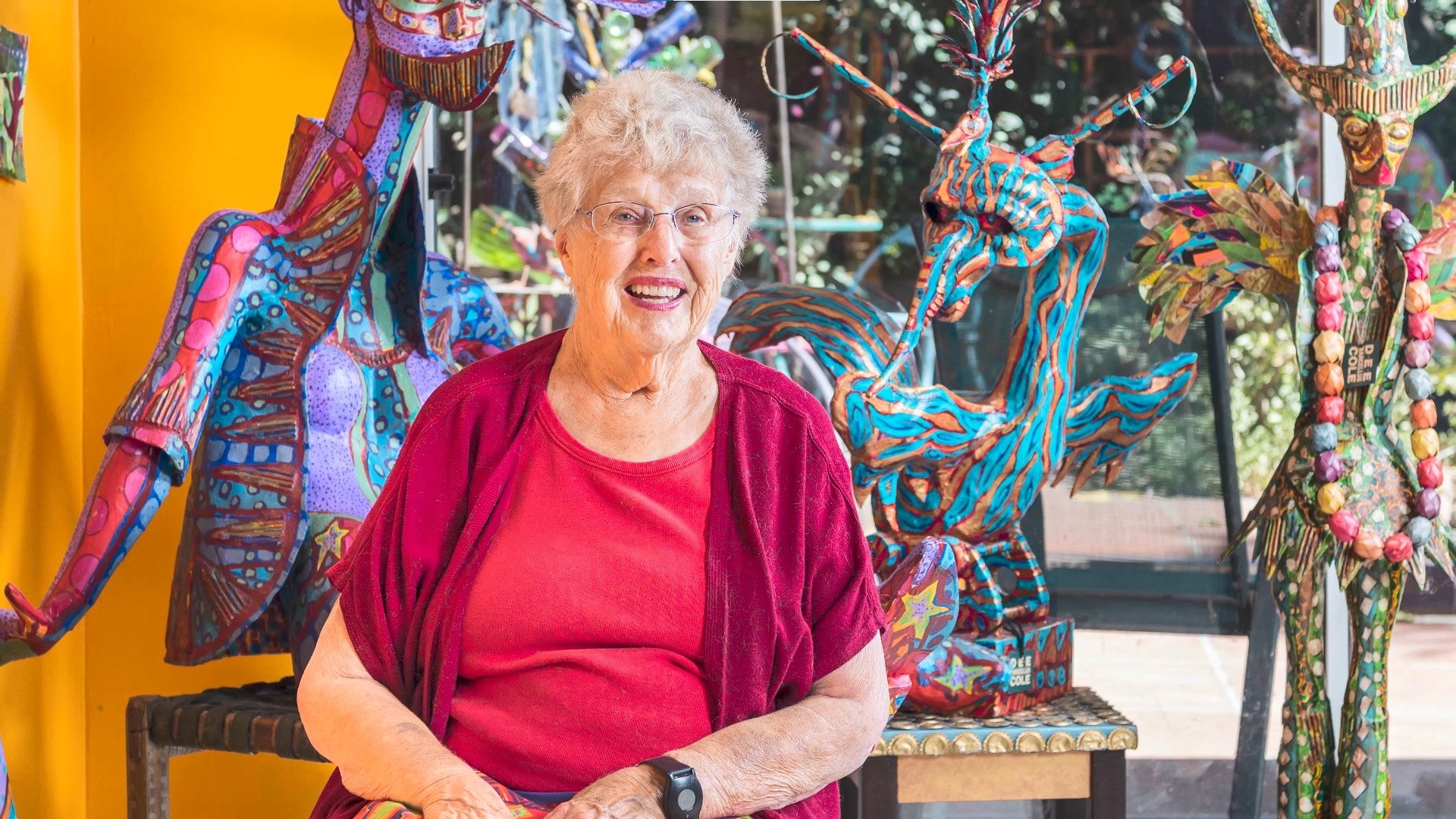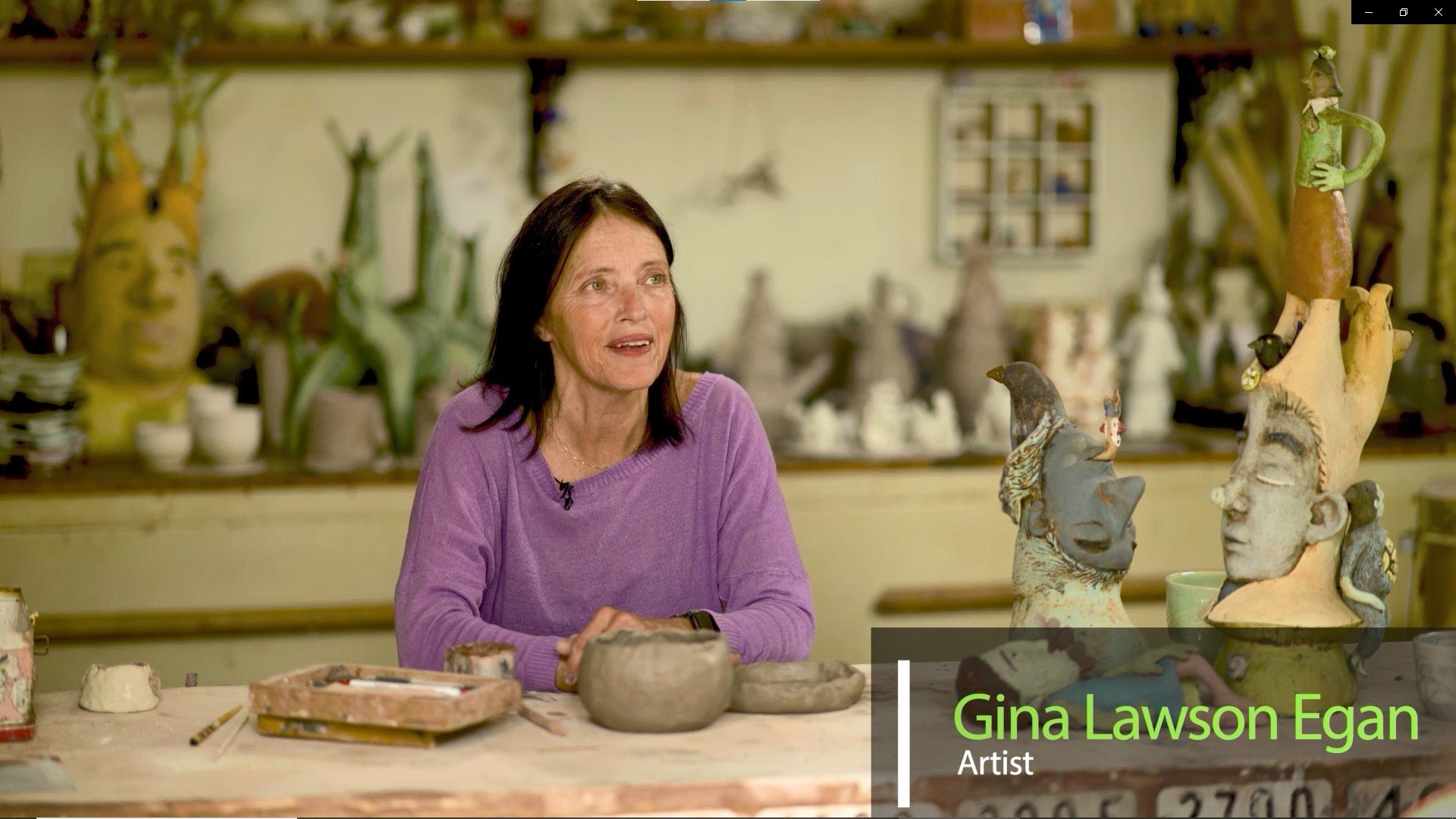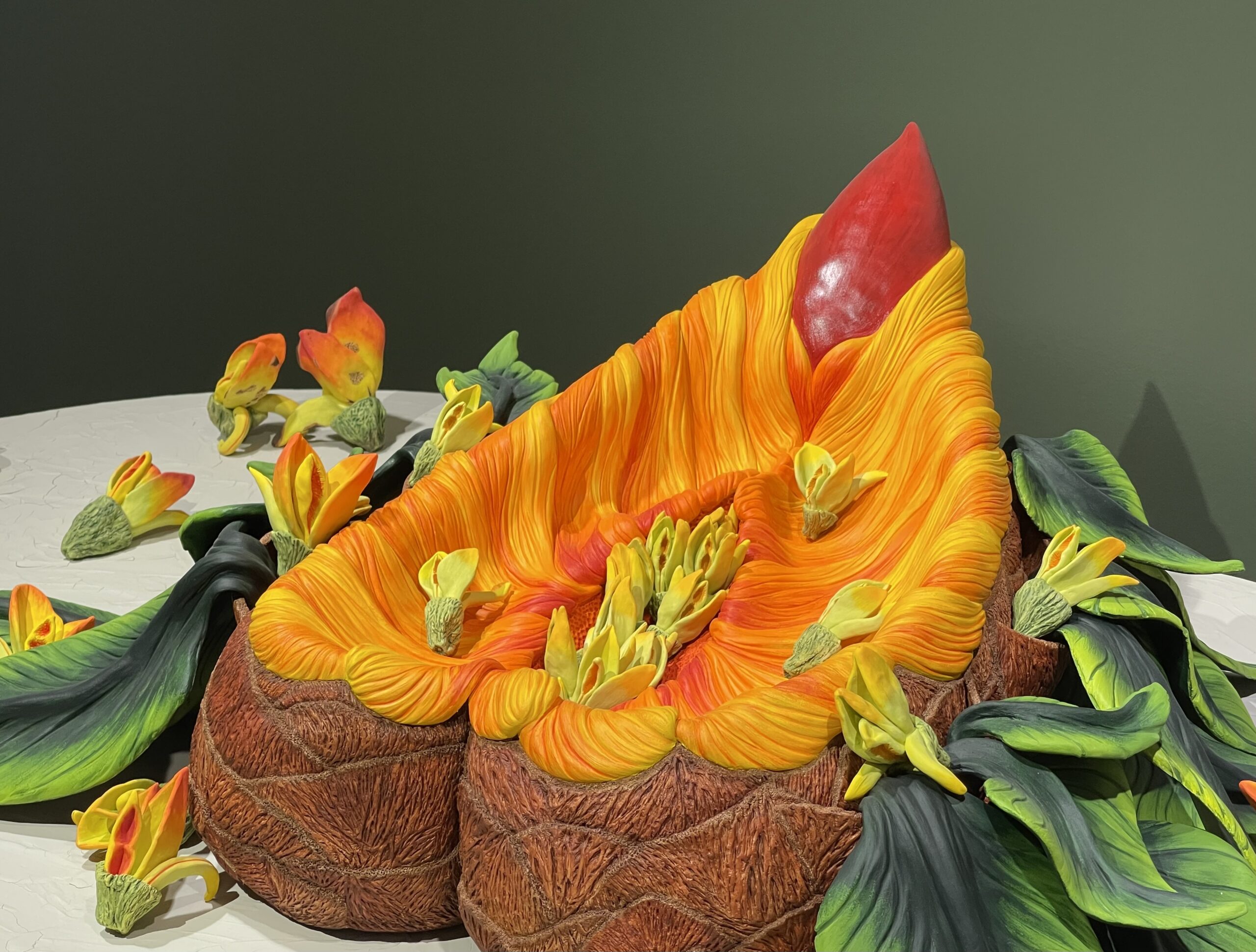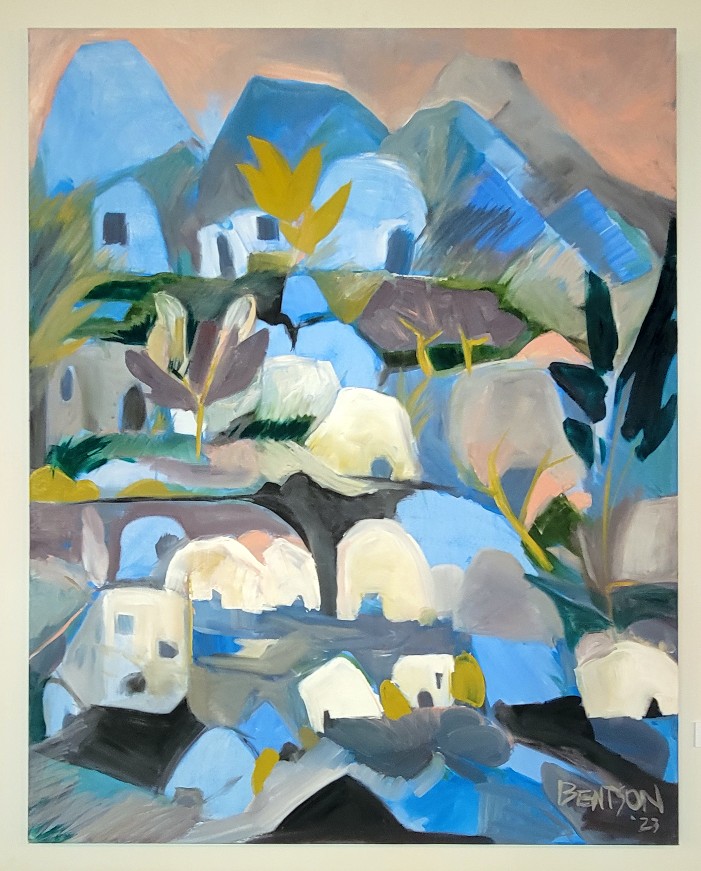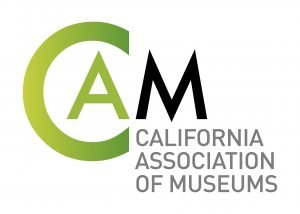In this video, guest curator Dr. Wendy Slatkin conducts a gallery tour of the exhibition Then & Now: Women Artists of the Pomona Valley – Founding a Legacy.
The Chaffey Community Museum of Art and the Ontario Museum of History & Art jointly produced the exhibition, with CCMA celebrating nine women artists who were active participants in the art scene of the Pomona Valley, beginning in the 1940s and OMHA featuring eight women artists currently mid-career.
All of the artists in the video are represented in CCMA’s collection and represent the tradition of meaningful and long-lasting contributions to art in the region.
Video Transcript
Hello, I am Dr. Wendy Slatkin, an art historian and guest curator of the Chaffey Community Museum of Art’s exhibition, Then and Now, Women Artists of the Pomona Valley.
The CCMA portion of the exhibition is subtitled Founding a Legacy and represents the then, while the Ontario Museum has mounted a companion show, Creating a New Legacy, which features works by local artists mid-career. Both exhibitions have been on display over the summer of 2022 to the legacy founders represented here are nine talented but quite diverse women who sustained successful careers as visual artists. By the 1940s, three Pomona Valley arts institutions were active, creating a synergistic nexus which permitted women artists’ talent and ambition to learn, live and thrive in the region. The art education available at Scripps College and the Claremont Graduate School attracted talented women from around the country. The jobs at the Millard Sheets Studio and surrounding colleges permitted some of these Scripps graduates to settle into the community. The exhibitions of the Chaffey Community Art Association CCAA, as the CCMA was then known, generated another locus of extraordinary opportunities for women artists in the Pomona Valley. These conditions formed the base from which the founding generation launched their careers.
Since the WPA-sponsored support of the 1930s, women were no longer isolated exceptions in the art world but comprised at least 40% of all art professionals in the USA. The nine women founders of this exhibition took full advantage of the educational options open to women for professional art training in the 1940s but then survived in relative isolation from a broader cultural environment of support. These artists worked as dedicated professionals who created impressive individual [indistinguishable], while often combining traditional roles of wives and mothers.
The first four artists, Barton, Bruton, Gilman, and Lundeberg, were drawn into the Pomona Valley art nexus through the opportunities presented by the CCAA, founded in 1941 by Francis and Helen Line. The CCAA sponsored a series of important exhibitions in the 1940s. Their works entered the collection via purchase prize awards or gifts of the Lines, and all were proudly exhibited to the public in the CCAA shows. We are honored to exhibit a select group of works of art by these nine talented and original artists in their local environment. They built a foundation, creating a powerful legacy, inspiring and often training future generations of women artists in the Pomona Valley.
Loren Barton
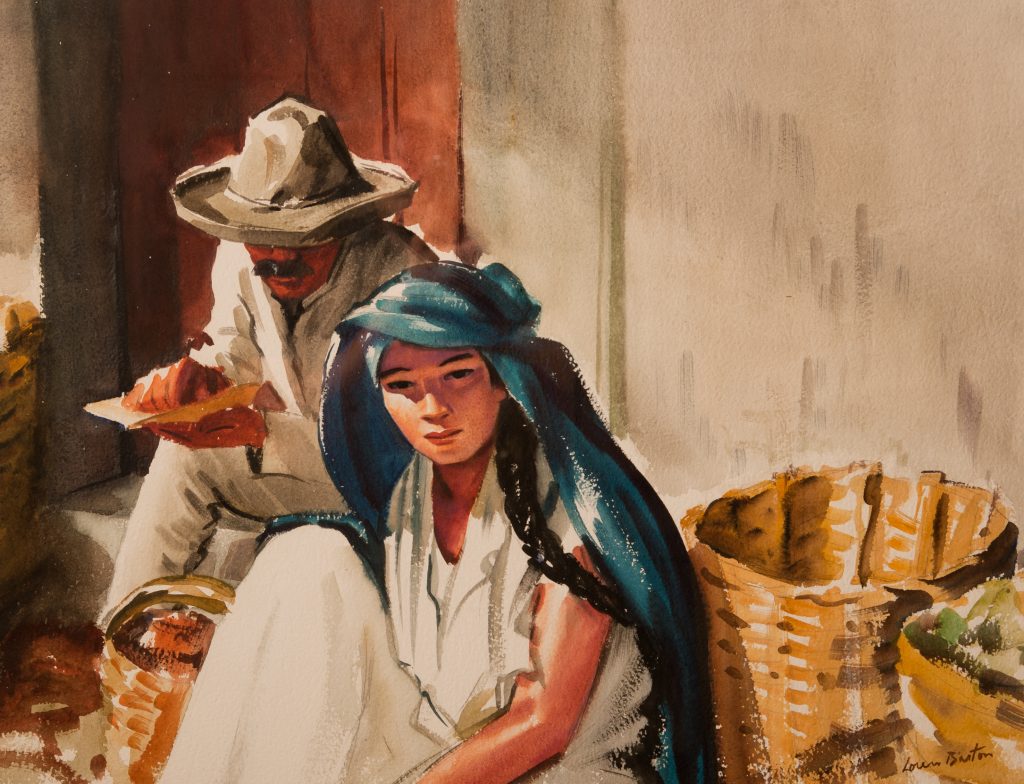
The first artist, Loren Barton, was one of the rare women artists who achieved a high level of professional recognition and success in the Southern California art world in the 1940s. She was born in 1893, in Massachusetts, in the home of her Great Aunt Clara Barton, founder of the American Red Cross. However, she was raised in Los Angeles and studied art at USC. Following in the footsteps of so many American artists, she traveled to Europe in 1929. In 1937, she returned to Los Angeles. From 1941 to 1947, Barton was on the faculty at the Chouinard School of Art, the region’s premier Art Academy, teaching with Rex Brandt and Tom Craig as one of the school’s three watercolor instructors. While the men often took students outdoors, Barton’s classes built basic skills using still life in the studio. Barton was in very prestigious company since Chouinard was positioned at the center of the explosion of the medium of watercolor, which defined California scene art of the era.
Barton’s subjects were varied but always featured recognizable, identifiable imagery. She chose themes taken from her immediate surroundings, including portraits and local genre scenes. She also favorites historical depictions of California in the Spanish period, as seen in Conchita. The work demonstrates Barton’s technical mastery in the medium of watercolor. The direct gaze of the young woman makes a strong connection with the viewer and surely encouraged the CCAA jury to purchase it at its inaugural exhibition. This has secured his place in the permanent collection of the museum. In 1951, Barton married and moved to the Pomona Valley. Here she continued to work on children’s book illustrations. She lived in this region until her death in 1975.
Esther Bruton

Esther Bruton, born in 1896, was the oldest of three sisters who lived and worked together in Northern California. All became accomplished artists with a high degree of professional recognition and success. During the 1930s, Esther, Helen, and Margaret collaborated on public projects sponsored by the WPA. Although Esther was especially skilled in mosaic, she also worked in oils, pastels, murals, printmaking, and etching.
The sisters remained unmarried and free to pursue their artistic careers until Esther, at age 44, married Karl Hooper Gilman. When Gilman was hired as a civil engineer in 1942, the construction of the Kaiser steel plant in Fontana, Esther moved to Ontario. As his wife, she was permitted to document the construction of this industrial behemoth. The eight works in Pigs to Pig Iron are the result of her access to the site. This was the largest plant of its type ever built, and the steel produced was used to build ships needed for the war in the Pacific. The Kaiser slogan was “From pigs to pig iron, Fontana Steel will build a new world.” Gilman appropriated this title for her remarkable series.
Following the creation of Pigs to Pig Iron, Gillman moved with her husband to San Diego. When asked why she created this series, she told the reporter, “I guess I couldn’t help doing them. I was fascinated by the pageant that was going on right under my nose, the rapid transformation of a quiet rural scene, orange groves and hog ranches, into that amazing seething bit of industry. It was a colorful pageant too. I liked the abracadabra rapidity of the construction period as if someone had rubbed Aladdin’s lamp, and it all rose up out of the orange orchards.”
After the war, the couple settled in Ojai. Several large-scale mosaic commissions for hotels in Honolulu are among her major works from the 1950s. Esther relocated to Monterey in 1983 to be close to Helen and Margaret. She outlived them both, dying of a stroke in 1992 at the age of 95.
Helen Lundeberg
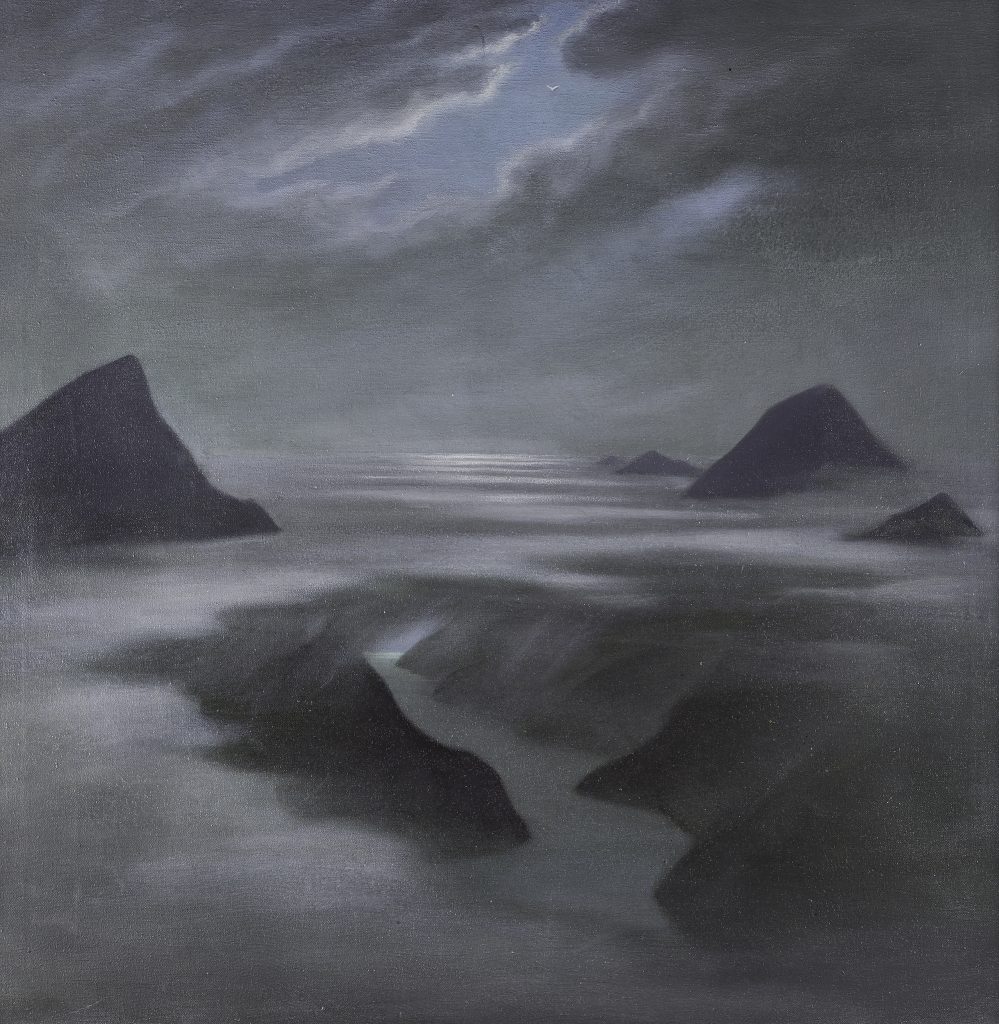
The third artist in our exhibition is Helen Lundeberg. She is widely considered to be the most important woman surrealist who was active on the West Coast. Born in Chicago in 1908, she arrived in California at the age of four with her family. In 1930. She met Lorser Feitelson, her teacher and future husband. Lundeberg and Feitelson founded a movement which they termed Subjective Classicism but also became known as post-surrealism. From 1933 until 1942, Lundeberg was employed by the California Federal Art Project. She designed a series of major mural projects. She was one of the few women artists included in the famous Fantastic Art, Dada, Surrealism show held at MoMA in New York in 1936. Her surrealist works, often including self-portraits, are well documented and acknowledged in histories of the movement.
Lundberg experienced a transitional period for about a decade when she used multiple styles, often with the misty imagery of the clouds, until she committed to total abstraction around 1958. The Clouds, which entered the CCMA collection as a purchase prize in 1949, retains recognizable imagery, lacks a human presence, and is mysterious and evocative. This image is intended to elicit an emotional response from the viewer. Lundberg characterized her artistic goals in the following statement, “My work has been concerned, in various modes of pictorial structure and various degrees of representation and abstraction, with the effort to embody and to evoke states of mind, moods, and emotions.” Clearly, The Clouds has achieved this objective. When viewed with these two other works from this period, we can appreciate the creative mind of a talented artist seeking to find a rapprochement between surrealist iconography and the powerful forces of abstraction, which were dominating avant-garde discourse in the 1950s.
Betty Davenport Ford
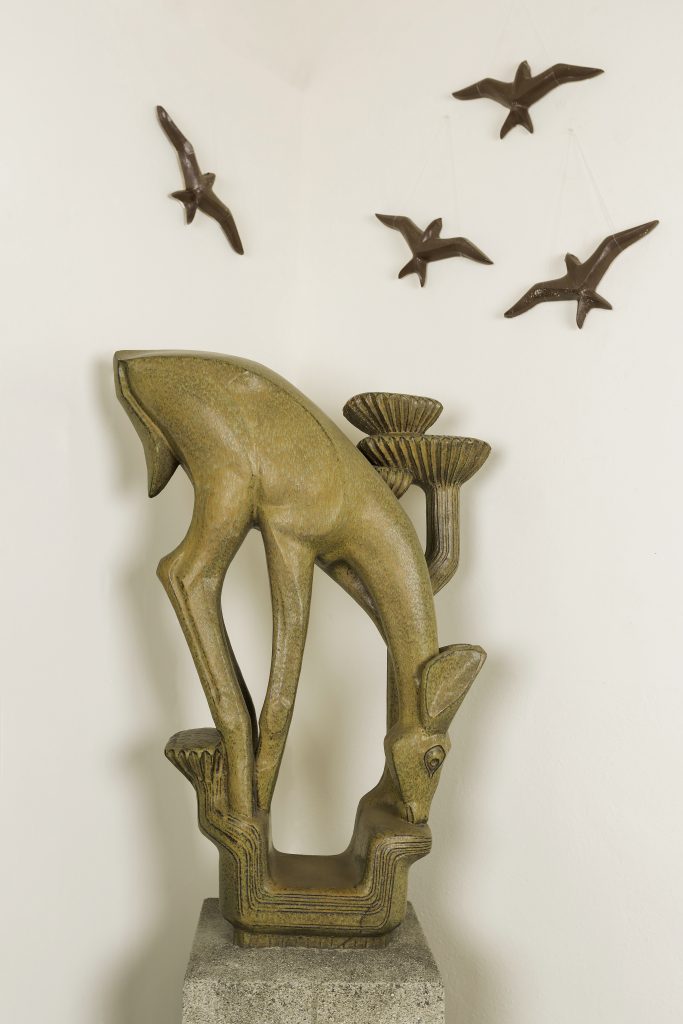
Born in Upland in 1924, Betty Davenport showed precocious artistic talent, which her parents encouraged. While still attending Chafey high school, she took art classes at Scripps and Pomona colleges. She studied ceramics with Suzy Singer, learning hollow-building and glaze techniques. She enrolled at Scripps and earned a BA in ceramic sculpture in 1946. Her precocious talents were noticed by Millard Sheets, who mentored her early career. In 1947, she married Harold Ford, an engineer and industrial designer hired by General Motors, and the couple moved to Detroit. There she pursued graduate studies at the Cranbrook Academy of Art and was awarded her MFA in 1950.
When they returned to the Pomona Valley, they built a home and studio near Sheets in the Padua Hills. It included a workshop, studio, and kiln room, where Ford could continue to produce her unique ceramic sculptures. Here they raised two children, and Betty pursued a successful career as a sculptor. She described her technique in the following way, “When I create a piece of sculpture, I go first to the subject, and I try to determine its essence, its soul, its mystique. It is perhaps a subject that I have known before, but suddenly I’ve seen it in a different way, a different character has emerged. I know it anew. I draw to capture the essence of the subject. But now I want to design too, a simplification, a symbol. I continue to draw to search for a combination of shape and Line that is new, unique, that I’ve never seen before, that is right.”
This life-sized gazelle, then titled The deer won first prize at the All California International Exhibition at the Laguna Beach Festival of the Arts in 1960. It is an excellent example of Ford’s concept of finding the essence, soul, or mystique of an animal. While maintaining the naturalistic detail of a recognizable gazelle. It has a strong abstract design. The legs unite on the left, which are counterbalanced by the sweeping, uninterrupted curve of the animal’s back and neck. The head forms the base on the right. Highly stylized plant forms create a counterbalance to the downward sweep of the gazelle’s back. The four birds are simplified, elegant forms which are mounted on the two intersecting walls and create an illusion of an environment or outdoor setting for the gazelle.
The charmingly animated running boar from the Maloof Foundation presents another aspect of Ford’s talent. It is detailed and dynamic, as opposed to the gazelle’s static elegance. Ford’s works have been exhibited in many local and national shows. She is most frequently associated with ceramic animals such as the Siberian Tiger of 1960, the mascot of Chaffey High School in Ontario. However, her [indistinguishable] also includes ecclesiastical sculpture. In 2001, she executed an elegant eight-foot bronze Madonna and Child, standing in the forecourt of St. Anthony’s Catholic Church in Upland. CCMA honored her with the designation of Artists of the Year in 2010.
Jean Goodwin Ames
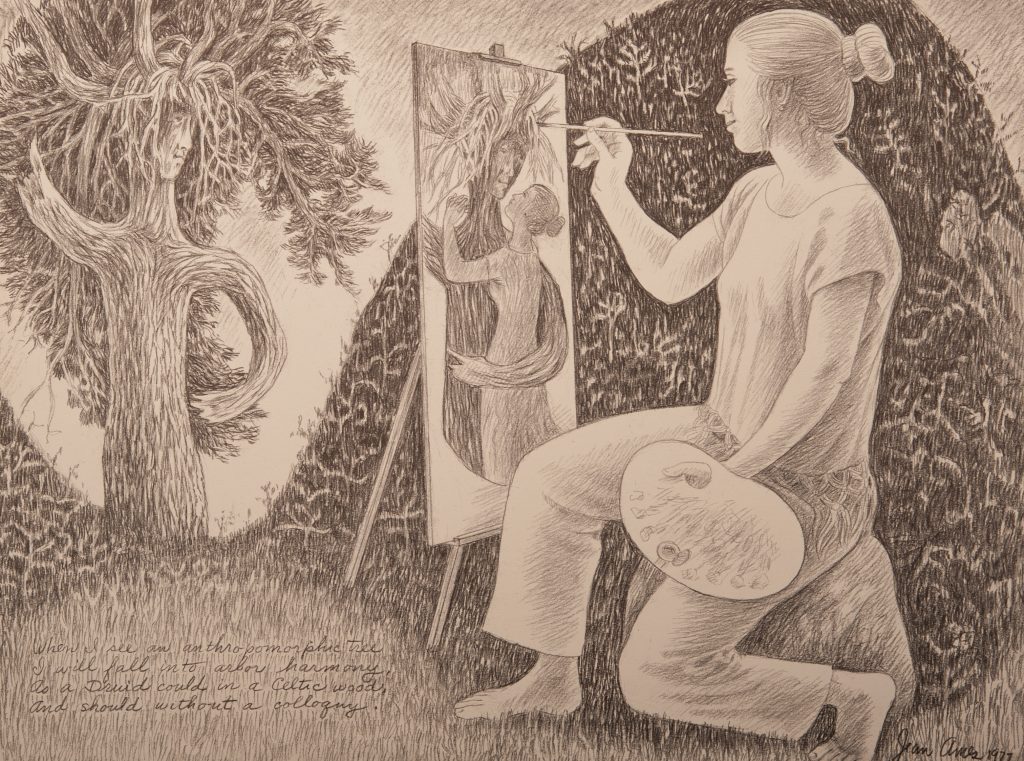
One of the most impressive aspects of Jean Goodwin Ames’s talent was her versatility, expressed in a wide range of media. She created paintings, sculptures, prints, tapestries, murals, lithographs, and mosaics but was best known for her work in enamels.
Born in Santa Ana in 1903, Jean Goodwin studied art at Pomona College from 1921 to 23 and at the Art Institute of Chicago, graduating in 1926. She then earned a second BA in education at UCLA and an MFA at USC in 1937. At USC, she met Arthur Ames, and they were married in 1940. Joining the WPA, Arthur and Jean were in the avant-garde of decorative mural and Mosaic artists. Ames was an important art educator as well. She taught at Scripps College and the Claremont Graduate School from 1940 to 1962 and then served as Chair of the Art Department at the Graduate School from 1962 to 1969. Her basic design course impacted generations of artists in the Pomona Valley and beyond. Jean and Arthur are usually linked in accounts of artistic achievement during this period, and their technical skills were no doubt developed in collaboration. But their approaches to iconography were quite distinct. While Jean pursued figural surrealist imagery, Arthur was known for his geometric abstract compositions.
Arthur Millier, art critic at the Los Angeles Times, described Jean in February 1939 as the most important woman painter in Southern California. Almost two decades later, in 1958, the Times named her woman of the Year in art.
Moon in the Thorn Tree was a Purchase Prize in 1950, and it is an excellent example of her personal iconography. Ames has defined her subjects in the following way, “My orbit seems full of angels and lovely sprites, all mingling with enchanted birds and beasts. Although I see these images within their abstract design, they are more of a motivation and possibly more important to me than the abstract elements in which I interpret them.”
The series of six lithographs here exhibited for the first time is a beautifully detailed set of images depicting tree spirits and an idealized young man and woman artist. The range of textures is extraordinary, and Ames also attached short poems to each print.
Susan Lautmann Hertel
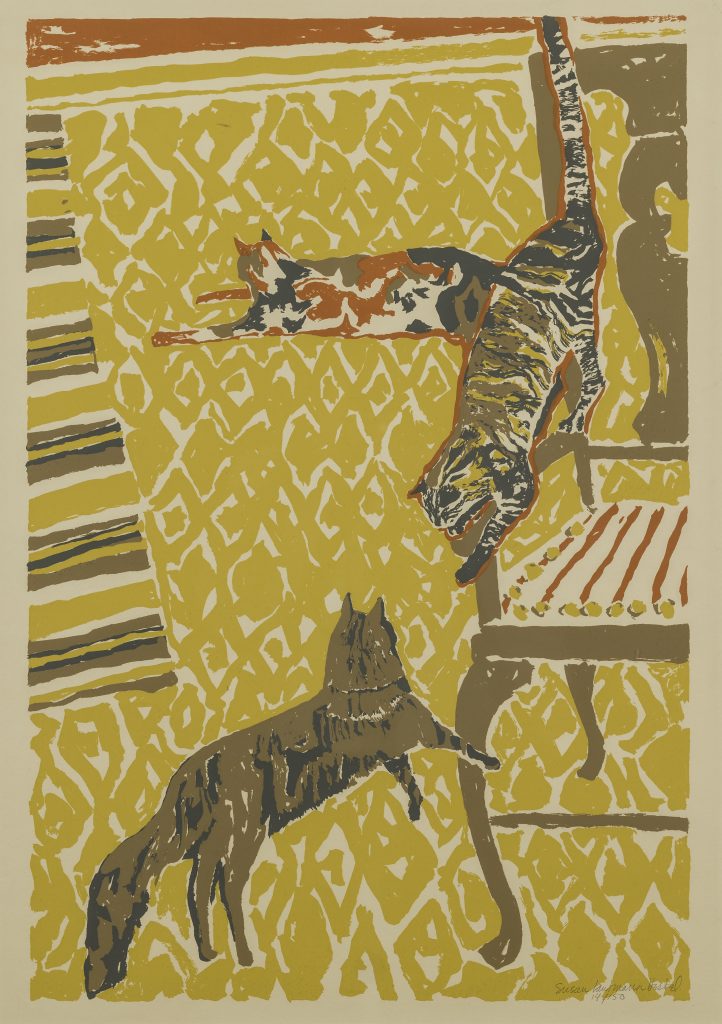
Susan Lautmann was born in Chicago in 1930. But she arrived in the Pomona Valley in 1948, when she enrolled at Scripps College. She was nurtured by Millard Sheets and Henry Mcfee and became the first Scripps graduate to work in the Millard Sheets Studio, beginning in 1957. Hertel took on greater responsibility there through the 1960s. She devoted her efforts chiefly to mural painting and Mosaic design. Working with Dennis O’Connor, between 1963 and 1982, she created eighty mosaic murals for Home Savings of America banks. As her children reached their teen years in the mid-1970s, Hertel had more time for her own painting.
Her elegant Woman Before a Mirror recasts the French impressionist and post-impressionist theme into a modern idiom. She often drew her subjects from the world around her, which was dominated by children, as well as a wide assortment of animals, including her favorites, horses. She developed a pantheistic connection with horses, evoking works by German expressionist Franz Marc.
Night Ride, borrowed from the Maloof Foundation, is a characteristic example of her art, which uses flattened spaces and simplified forms with arresting color combinations. She was also skilled in printmaking, as these two examples, the Untitled serigraph of three distinctive cats and the monochromatic Billy Goats reveal.
Shortly after the Hertels relocated in 1982 to a ranch in New Mexico, Susan was diagnosed with breast cancer. Sadly, her cancer recurred in 1991, and she died at her ranch in 1993. Hertel worked largely without the support of the feminist art movement of the 1970s, yet developed an independent style of the highest quality and her surviving [indistinguishable].
She was also a poet, and this excerpt from one of her poems sums up her identity, “I am a dog person, a horse person, a hawk person, a hill person, but I am not a person of the people tribe. I am an immigrant among the animals. We communicate imperfectly. Still, I am welcome”.
Martha Menke
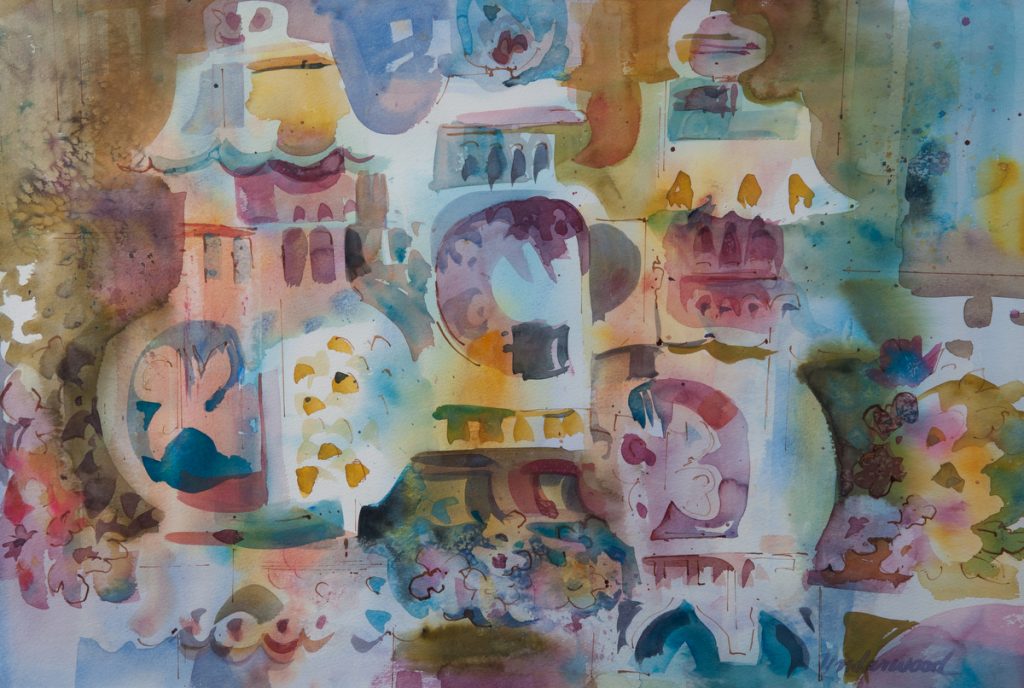
Martha Menke, born in 1934, enrolled at Scripps College, where she studied with Millard Sheets. Phil Dyk, Jean and Arthur Ames, Robert Wood, and Milford Zornes, and was awarded her MFA from Otis Art Institute. In 1958, she was hired by Millard Sheets to work on mosaics. Soon after marrying S. David Underwood in 1962, an architect also working in the Sheets Studio. She left the studio to accept a full-time teaching position at Chaffey College. She taught courses in graphic design, children’s books, illustration, printmaking, and fiber arts, as well as watercolor painting for 27 years. Underwood retired in 1996 and found more time to paint, mainly in watercolor. Her expertise and versatility in the medium are quite evident in these works. Underwood’s late watercolors continue the powerful tradition of the medium, which burst onto the art world in the United States with the California scene painters of the 1940s.
“I find rich inspiration for my watercolors wherever I go. I often paint spontaneously from the colors and shapes, which are more abstract and purely personal.”
Her commitment to watercolor testifies to its ability to remain a sensitive medium of individual creative artistic expression, as seen in this series of four works. She was recognized for her talent in 2008 when she was named Artist of the Year.
Andrée Mendenhall Mahoney
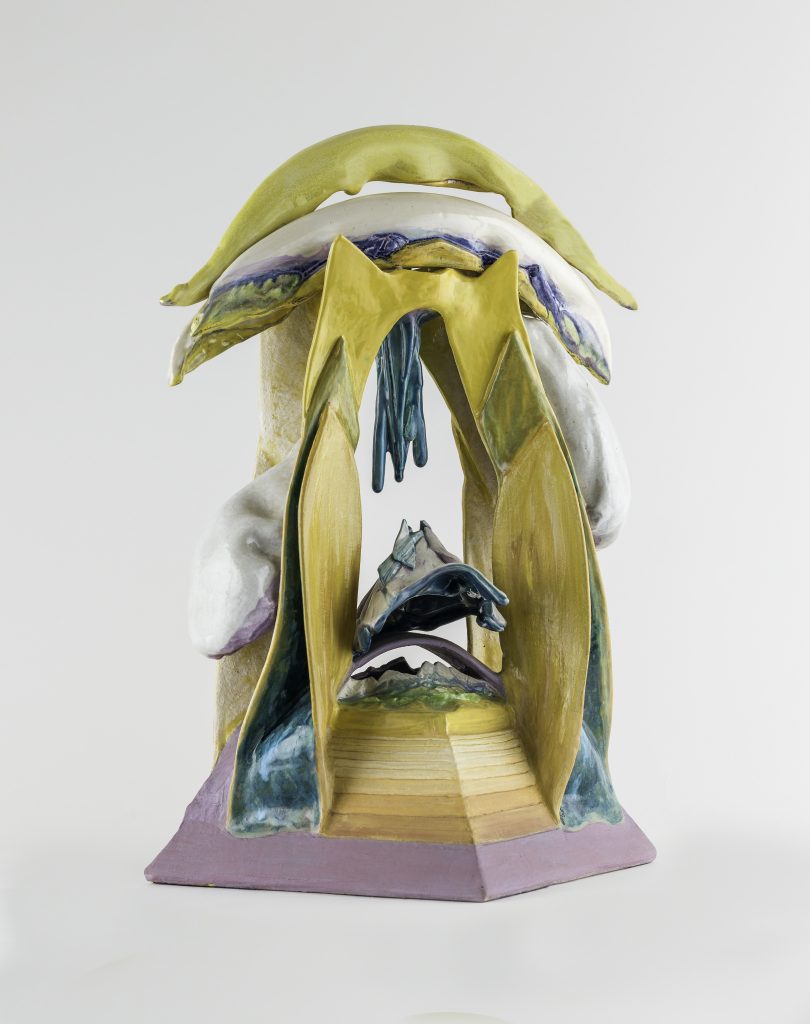
Andrée Mendenhall was born in Hawaii in 1932 and spent her early childhood there. However, her entire professional life has been spent here in the Pomona Valley. She arrived initially to study at Scripps College and was awarded her MFA in painting and ceramics from the Claremont Graduate School in 1968. Paul Soldner introduced her to abstract expressionism, but it was Harrison McIntosh who first recognized her talent as a ceramicist.
In the fall of 1959, Martha Menke Underwood hired Mendenhall Tolstoy, as she was then known, to work in the Sheets Studio in the mosaic section. Andrée worked closely with Underwood as well as Sue Hertel, Nancy Colback, and Dennis O’Connor. She joined the Chaffey College Art Department in 1963, where she continued to teach until her retirement in 2000.
Like Jean Goodwin Ames and Martha Underwood, Mahoney has taught art to many generations of young artists in the Pomona Valley. This four-part painting demonstrates her awareness of theosophy and other spiritual systems. A sense of limitless cosmic space is evident, especially in panels three and four—the colors pulse with movement and vibration. The connection with senses other than sight is apparent, as is the contrast between the warm red hues and the cooler blue-green of the other panels, which also establishes an opposing duality. The triangular vectors contrast with some of the organic shapes, giving a sense of geometric control. Her paired ceramic works, Temple to the Mountain-Day and Night, are good examples of her beliefs in duality.
“A very strong part of art history is illustrating the negative or dealing with emptiness… war… death… the other side of things. It’s the opposite of light.”
Andre currently resides in the Red Hill area of Rancho Cucamonga in a remarkable home that was originally a fire lookout station. There she lived with her husband, Jerry Mahoney, raised her children, and worked quietly producing paintings and ceramics that express her original visions.
Recognized as the 2009 Artist of the Year. She is a true treasure of the Pomona Valley and a living inspiration for all artists.
Florence Arnold
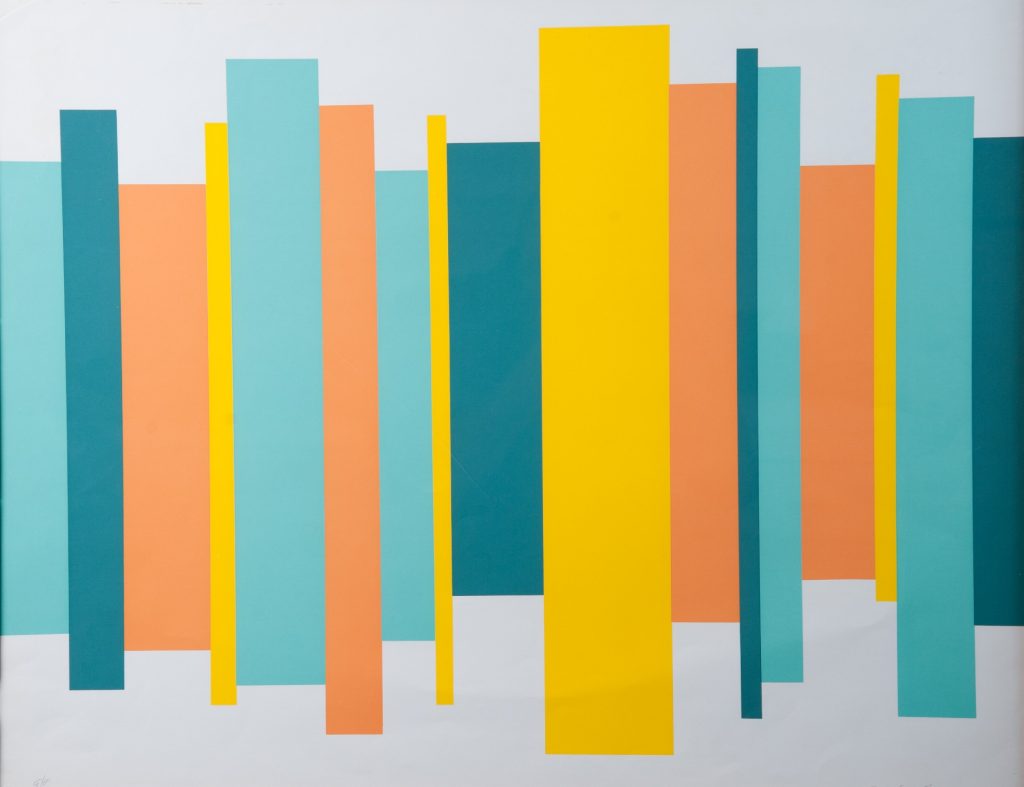
Florence or Flossie Milner was born in Prescott, Arizona, in 1900. She earned her BA in 1926 at Mills College in Oakland, California, and continued her formal education at USC, where she was awarded a BA in education in 1939. She married Archie A. Arnald in 1925, and they settled in Fullerton. She taught music at Fullerton High School from 1941 to 1947 and in the Buena Park School District from 1948 to 1966. Around 1950, Arnold studied at the Claremont Graduate School under the mentorship of noted hard-edge abstractionist Karl Benjamin.
Florence Arnold only discovered her passion for painting at the age of 50. During the last decades of her life, she became a talented, committed minimalist painter during the 1950s. This Claremont-based community was essential to Arnold’s activity as a painter. She regarded Paul Darrow, Doug McClellan, Frederick Hammersley, and Jack Zajac, as well as Benjamin, as kindred spirits. For about a decade, from 1959 to 1969. She exhibited with this Claremont group, also known as Abstract Classicists, in Europe and the United States.
“I couldn’t live without music. I don’t want to… I don’t want to live without color. I don’t want to live without art. But mostly, I don’t want to live without people. People are the most elegant things in this world, the give and the take, and the fun of communicating comes from people. And art is a means of communicating, the same as music.”
The series of four works, Themes in a Square, is characteristic of Arnold’s severe geometry, abstract vocabulary, and beautiful original color combinations. It is also an important example of a major trend and Claremont-based artwork of the era.
Due to the support of Robert George, the CCMA collection contains a number of major works by Arnold, who passed away in 1994.
It has been a true pleasure to organize this exhibition, which unites for the first time these nine women artists, who discovered that the Pomona Valley was fertile soil for the flowering of their artistic visions. They are only a few examples of the women founders who supported the next generations of women artists in our community.
